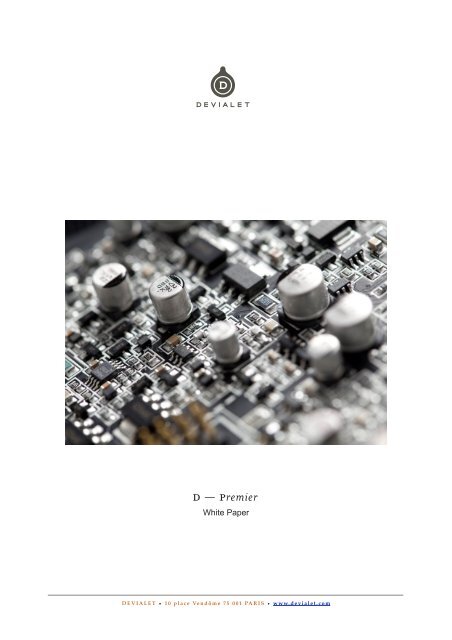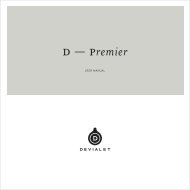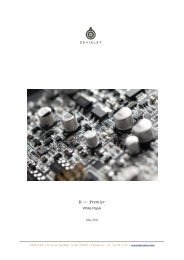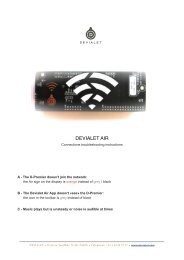D-Premier-White-Paper Munich - Devialet
D-Premier-White-Paper Munich - Devialet
D-Premier-White-Paper Munich - Devialet
Create successful ePaper yourself
Turn your PDF publications into a flip-book with our unique Google optimized e-Paper software.
<strong>White</strong> <strong>Paper</strong>DEVIALET • 10 place Vendôme 75 001 PARIS • www.devialet.com
21st century High End Audio TechnologiesPatented DAC design and Analog Digital Hybrid amplification technology(ADH hybrid core®): "The best of both worlds"• musicality of the Class A (voltage control) and efficiency of the class D (current output) working in parallel• "power steering"-like design with the Class A amp in the driver's seat• patented ultra-linear unity gain class A amplifier• revolutionary 24/192 DAC located in the core of the Class A amp: patented zero processing I/V conversion• best performances in real use conditions on every measurable criteria: THD, IMD, Output impedance, SNR...Exclusive HD asynchronous Wi-Fi streamer: "The best cable is no cable"• HD asynchronous Wi-Fi data transmission protocol• Internal DAC master-clock ensuring zero jitter reproduction• smart buffering: instantaneous start and robust stream• iTunes-based control interface with multi-device access• seamless HD streaming from iTunes21st century high precision phono stage: "Serving the LP musical heritage"• low noise and hum-free differential design• universal configurable MM/MC cartridge compatibility• high precision digital RIAA processing• LP ripping HD digital outputUltimate daisy chaining capability: "Stacking layers of pleasure"• even more power and performances: 2x400 W and 0,00025% THD in dual mono• easy master - slave connection, stacking and control• digital synchronized link• multiple chaining options: dual-mono, bi-amp, multi-roomFree online advanced customization tool: "Your amp, your mood, your settings"• intuitive web-based interface• advanced information and support• extensive settings options: performance enhancement, comfort of use and protectionFirst fully upgradable platform: "It's getting better all the time"• software-driven analog hardware platform with 8 processors• "down the road" feature activation and performance improvements:• 2011: software upgrade 5.3 offering better sound quality (more powerful and responsive power supply) and newfeatures (ex: daisy chaining)• next: streaming, HDMI, active cross-over filtering, DSP-based optimization (ex. speaker/electronics matching)• easy SD card software loading processUltimate audiophile hub: "A team can be more than sum of its parts"• best-in-class design for every function: inputs, power supply, ADC, DAC, Class A, Class D, remote• 5 patented major innovations• optimal interlinked architecture• straight-wire integration philosophy: zero processing, shortest pathGreen technology: "Smart Power"• reduced power loss and heat dissipation: 85% efficiency for 2x240 W• efficient planar transformer power supply (600W and 2100W peak): Power Factor Correction (PFC) and reducedhardly recyclable storage components• green design and materials: small aluminum chassis, RoHS standard PCBs, no wires and insulatorsD-<strong>Premier</strong>!<strong>White</strong> <strong>Paper</strong>2
TECHNOLOGY INSIGHTWhy does it sound so good?<strong>Devialet</strong> D-<strong>Premier</strong> is the first amplifier based on ADH Technology, along with numerous other highly innovative <strong>Devialet</strong>exclusiveprinciples. They are all aiming at offering the best sound - whatever the speakers associated to the unit - aswell as the most user-friendly and enjoyable experience. In short: «Technology made simple».This white paper presents the main technologies invented by <strong>Devialet</strong> for D-<strong>Premier</strong>.ADH hybrid core: patented Analog Digital Hybrid amplification technologyThe original idea and first patent, which dates back to 2004, is tocombine the two opposed technologies of amplification - analog anddigital, aiming to obtain the best of both worlds: the linearity of themost acclaimed analog amplifiers (class A) with the power,efficiency and compactness of «digital» amplifiers (class D).Although simple to explain, this alliance rapidly proved to beextremely difficult to implement, since it basically means connectingthe two amplifiers in parallel. Finally, 4 years of extensive researchwere needed to achieve a working prototype.A voltage currentcontrolThe principle of Analog Digital Hybrid is simple:• A genuine class A amplifier directly connected to the speakerdrives the output voltage: as the master, it sets the sound of thewhole ADH core, that’s how what we hear is an analog amplifier.• A digital amplifier is added in parallel to provide most of thecurrent to the speaker. It is «slaved» to the analog amplifier sothat it minimizes the current of the class A.CTRLDDDAn illustration of this principle is the power steering of a car: the driver is assisted by a powerful engine to turn the wheelsas they should be, easily hence precisely.Two additional benefits derive from this successful association:• The class A amplifier, which «sees» a much easier (read: ohmic) speaker to drive, corresponding to the current ratio ofabout 1:100 between both amplifiers, is made even more linear: as unexpected as it sounds, it is improved by thedigital amplifier... Imagine that when you connect an 8 ohm-speaker, the class A in ADH only sees a light headphoneequivalent load of 800 ohms to drive.• The output impedance of the ADH core is equal to the class A impedance divided by this same assistance ratio: that’show a less than 1 milli-ohm figure is achieved over the whole bandwidth (not only the lows), which is so important tomaintain all the other quality parameters against real, non-perfect speakers.ADH Technology, combined with <strong>Devialet</strong>’s exclusive DAC in a very favorable architecture, is responsible for D-<strong>Premier</strong>’ssound transparency, immediately recognizable.Innovating, optimal system architectureAs good as it may be, the amplifier itself is not enough to offer a comprehensive audio solution: a lossless connectionbetween the source and the amplifier is needed. The vanguard architecture of <strong>Devialet</strong> D-<strong>Premier</strong> breaks the traditionalboundary between blocks, and removes interconnects between appliances, since the DAC and the class A amplifieroverlap to make the shortest possible signal path of any audio system ever built: less than 5 cm / 2 in. between theresistances where the music voltage is born and the speaker binding posts. This is at least 10 times shorter, without allthe possible degradation of an external interconnect: hum, noise, bandwidth and impedance matching. Moreover, theDAC directly outputs the same high voltage that is expected at the speaker output, so the ADH amplifier works at unitygain. Overall only 2 resistors and 2 capacitors in the whole system handle the music. No gain stage based on feedbackwith questionable impact on distortion, no nothing.D-<strong>Premier</strong>!<strong>White</strong> <strong>Paper</strong>3
Patented ultra linear, unity-gain class A amplifierA specific class A amplifier is required to do the job in the ADH core: although it is most of the time highly assisted by theclass D in providing current to set the ideal voltage to the speaker, it must also be able to output a high current over ashort period of time, and absorb the ripple current of the digital amplifier. So it needs both a high current output capabilityand a low output impedance at high frequency.This is achieved by a very innovative non-linear polarization scheme which allows a virtually infinite current while stayingin class A, combined with a low power consumption. The intrinsic linearity and output impedance of this class A comparewith the best units on the market, but remember they are further abundantly improved by the ADH combination.A comprehensive demonstration highlighting the analog amplifier of the ADH core is to remove the digital amplifierdaughter board: D-<strong>Premier</strong> still delivers very transparent sound, and only enters thermal protection when pushing thevolume for too long.Patented ultra linear, high-voltage DACMoving further upstream, the DAC is the next key block of the chain that sets the music quality. It has been designed inlight of the following observation: processing means altering. At system level, the gain stage is removed and the path ofmusic is minimized for this reason.In the DAC, the output current of the highest performance device available (T.I. PCM1792) is directly converted into highvoltage without any processing in between: no operational amplifier, no current mirror. Instead, a fully original verycomplex leak-less path is designed to carry the original current of the DAC to the only two ultra high-linearity resistors inthe system. The magic comes from the fact that the guiding elements around this path do not process the music.Besides, the characteristics of any device is related to its temperature, so if temperature changes, music renderingchanges as well. To make the system thermal distortion-proof, all the parts which build the guiding boundary aredesigned to operate at constant power (dual cascode), hence constant temperature.Patented single-stage, low noise, PFC power supplyThe energy-efficient ADH coreis fed by a very specialswitched-mode power supply:unlike so-called «linear» powersupplies and traditionalswitched supplies, it drawspower from the mains the way alight bulb does, following a veryclean sinusoidal waveform.This not only complies withregulations applicable to higherp o w e r e l e c t r i c a l d e v i c e srequired to perform PFC -Power Factor Correction, butoverall ensures a very low noisesent to the mains and to theinternal blocks.VI50/60 Hz * naudio band“Linear”current spikeSwitched-mode PFCsmooth transferOn the contrary, drawing anaverage 10 Amps from themains using crest-rectification ofa linear supply transmitting power only 10% of the time generates current spikes of 100 Amps, 100 or 120 times persecond: all the harmonics of this disturbing noise source lay exactly in the audio band...In D-<strong>Premier</strong>, the PFC feature is obtained with a single stage energy processing, hence less power loss and thetraditional wire-wounded transformer is replaced by an in-house designed planar transformer made of very technologicalPrinted Circuit Boards ensuring repetitive and much lower parasitic values. The processor-controlled supply of D-<strong>Premier</strong>also features extremely fast response to load transient and requires a much smaller amount of energy storage.tfVSVI50/60 Hzaudio bandtfD-<strong>Premier</strong>!<strong>White</strong> <strong>Paper</strong>4
Performances: parameters, figures & musicD-<strong>Premier</strong> has been thoroughly designed after identifying the appropriate parameters and associated figures setting anew standard defined as Live and Lossless® sound. Well known, traditionally discussed parameters prove to beinsufficient to really qualify the transparency of an amplifier, which explains the extensive listening tests associated tomeasurements in the reviews. That's why we worked on defining our specific approach regarding these parameters.Here is a key list against which D-<strong>Premier</strong> was evaluated throughout its design:• Signal-to-Noise Ratio (SNR), reflects the noise floor level under which music becomes masked, ruining the originalambiance and emotion during pianissimo moments; experience shows that although human ear is able to dig toneswell below the noise level, pushing this standard very far makes a noticeable difference, especially with high resolutionrecordings• Total Harmonic Distortion (THD), reflects the amount of spurious harmonics added to a single tone, hence timbersfidelity, since instrument sound signature is made of the ratio between these harmonics• InterModulation Distortion (IMD), reflects the amount of spurious combinations of several tones: beyond THD, a verylow IMD is mandatory to render the sound of a large orchestra without adding blur and to provide the original spatialdefinition without mixing the multiple paths of sound together• Frequency response, in both amplitude (BW) and phase, defines the sound scene breadth and breath integrity, as wellas the accuracy of high pitch timbers (for example, muted trumpet which tends to become aggressive with a non-linearphase response)• Output impedance (Zout), defines the stiffness with which the amplifier sets the output voltage against the speaker’snon-linearities and resonances (intrinsic and room’s); without an extremely low figure of this parameter, all the abovediscussed qualities measurable on ideal lab loads are lost in real life condition; the math is simple: take a low distortionvalue for a speaker of only 1% (-40 dB): to maintain a -100 dB THD figure (0.001%) thru this speaker, an impedanceratio between the amplifier and the speaker of 1:1000 is required that is, for a 4-ohm speaker, a maximum outputimpedance of 0.004 ohm• Thermal distortion: since the characteristics of any electronic device depends on its temperature, a variable workingpower leads to a non-constant operating temperature, hence non-constant sound reproduction; various time constantsof thermal inertia are found, leading to different kinds of impact on sound: short term thermal distortion alters thegroove and the phrasing integrity - a system without this artefact is perceived as «fast», and non-tonal sounds likepercussions become incredibly realistic; a longer term effect reduces the immediacy of forte / piano subito, and theemotion deriving from this contrastnoisefff SNRSignal / Noise Ratio THDHarmonic Distortion IMDInterModulation Distortionf 1 f 2t ZoutOutput impedance BW & phaseBandwidth, phase rotationf ThermaldistortionD-<strong>Premier</strong> has been designed with strictly no compromise on any of those parameters, pushing the studies viapermanent mutual challenge within the team. This is how the following figures were achieved:D-<strong>Premier</strong>!<strong>White</strong> <strong>Paper</strong>5
PARAMETERS «HIGH END» D-PREMIER RATIO CONDITIONSNR 100 dB 130 dB 1:30 unweightedTHD 80 dB 100 dB 1:10 full PIMD 70 dB 100 dB 1:30 SMTPEZout 100 mΩ 1 mΩ 1:100 full BWBW30Hz~10kHz5Hz~60kHzDC~30HzDC~95kHz1:3 -0.1 dB-3 dBPhase20°35°0.4°1.8°1:501:2020 kHz40 kHzThermal Distortionnon measurableVersatile DSPD-<strong>Premier</strong> has been designed as an open platform which integrates numerous configurations and meets everyone’sneed, by adding a DSP at the crossroad between inputs and outputs (ADH, S/PDIF output, analog pre/sub-out): instandalone stereo mode, the DSP acts as a straight wire and only performs volume control and RIAA phono correction;yet, this full-featured floating-point engine (SHARC) is available for extended uses.Careful studies proved that the optimal (read: most linear) volume control is today achieved in the digital domain, that’swhy the analog inputs are also internally routed and handled as balanced inputs, the outer RCA ring being insulated(doubled chain, removing the traditional ground noise and distortion), then sampled at 24 bits, 96 or 192 kSPS by aprofessional, ultimate performance ADC (T.I. PCM4220).mainPSUPSUADHcoreDx 2Wi-FiHDMIAES/EBUS/PDIFLinePhonoInputProcessorDSPDADAASpeaker outAnalog preoutDigital out21st Century high precision phono stage: "Serving the LP musical heritage"D-<strong>Premier</strong> is not only designed as an ideal digital-in amplifier. It includes an unprecedented high end configurable phonostage (compatible with all cartridges: MM, MC, stereo and mono without Pre-Pre required.), also taking advantage of thesynergies of a close integration with our unique amplification technology.• Low noise and hum-free differential design:Considering the electrical radiations (mostly captured in the ground) affect equally the ground & signal wires coming outof the cartridge, the differential topology removes unwanted noise and parasitics. Tonearm grounding is no more anissue, and our dedicated phono ground connection is not necessarily needed.D-<strong>Premier</strong>!<strong>White</strong> <strong>Paper</strong>6
• Universal configurable MM/MC cartridge compatibilityD-<strong>Premier</strong> phono input features a configurable resistor and a capacitor array. More than 100 presets are available to finetune the audio result with any MC/MM cartridge. The configurator interface on our website allows you to easily adjustthose settings.• High precision digital RIAA processingDigitalizing is especially well suited for phono signals: since the RIAA processing applied during mastering enhanceshigh frequencies, a greater resolution is obtained in the frequency range where it is most needed. We get more bitsavailable to describe very small and fast wave forms. The RIAA correction is done in the digital domain using our realtimehigh resolution DSP capabilities. The precision of the applied correction regarding the theoretical curve is moreaccurate than +/- 0,01 dB, whereas 0,5 dB is a high performance for an analog design. Moreover, the same RIAAaccentuation does not match all recordings. With D-<strong>Premier</strong> you can instantly select the appropriate reverse RIAA curvebetween 1953 standard and post 1976 revision (using the central button of the remote control). Older correction curvesare also available on request because we do not forget records released before 1953!• Single stage gain without additional noise nor distortion nor range limitationD-<strong>Premier</strong> performs RIAA correction and signal amplification in distinct stages. We fully benefit from the synergies of theintegrated architecture of D-<strong>Premier</strong>. Since it is a unity gain amplifier - where the digital signal is directly converted withthe output voltage applied to the speakers - adding gain is just doing the math! It can't be wrong, non-linear nor limited,and it cannot be unbalanced neither between left and right channels. Unless you decide to do so in order to compensatea non-perfect position of the cartridge between vertical/horizontal axes i.e. L/R channels. All the quality of ouramplification design also contributes to the audio result: ultra low noise floor, low distortion and intermodulation, dynamicresponse and power.• LP ripping HD digital outputThanks to its output with configurable sampling rate up to 192 kHz/24 bit, D-<strong>Premier</strong> is also an ultimate LP ripper,bridging past recording technology and our digital era.Exclusive HD asynchronous Wi-Fi streamer: "The best cable is no cable"Since the very first D-<strong>Premier</strong>, all units are ready to receive an additional streamer module through an easy operationand software upgrade. Looking to offer the best sound quality with the smoothest user experience, we always consideredstreaming as the best possible input for D-<strong>Premier</strong>.Our technology and choices are based on:• a HD asynchronous Wi-Fi data transmission protocol with smart bufferingThis is the only way to do things the right way: transferring the music as data packets via a data transmission protocol,recomposing the music files, and "play" them internally. So we developed our own solution based on Wi-Fi 802.11nstandard. It ensures data packets transmission integrity and continuity, using multiple backup methods and a smartbuffering approach. This buffering is constantly optimized in order to have an instantaneous start and robust stream atthe same time.• an Internal DAC master-clock ensuring zero-jitter reproductionHaving a single clock running the signal throughout the system is a key concept of jitter-free digital transmission.Therefore, the internal DAC clock of D-<strong>Premier</strong> controls all the data transmission and replay process from the computerwhere the files are stored to the DAC.• an iTunes-based control interface with multi-device accessWe choose iTunes as an interface for the streaming. It is the most universal, user-friendly solution, and most of all, itnatively offers multi-device access. An iPod, iPad or iPhone can be used as a remote to control iTunes on a computer.So iTunes is only where you select your tracks - and just that - since the music files are actually «played» inside the D-<strong>Premier</strong>. A driver installed on the computer sees what iTunes is doing and interacts accordingly with the D-<strong>Premier</strong>. FLACfiles users can easily convert their files to other lossless formats and transfer all their library to iTunes. Even highresolution files up to 192kHz / 24bit can be used, since the limitations of iTunes for handling HD files is not no longer anissue with our process: no other software is needed.Future software upgrades will extend the possibilities of the streamer, supporting Airplay protocol or being recognized asan external sound card by the computer.D-<strong>Premier</strong>!<strong>White</strong> <strong>Paper</strong>7
Ultimate daisy chaining capabilitiesSeveral D-<strong>Premier</strong> units can be daisy chained:• in order to get even more power and performances: 2x400 W and 0,00025% THD in dual mono• through an easy master - slave connection, stacking and control operation• with a digital synchronized link• and multiple chaining options: dual-mono, bi-amp, multi-roomFree online advanced customization toolD-<strong>Premier</strong> is also configurable to the exact user's need. A web-based user friendly interface helps customize virtuallyeverything in D-<strong>Premier</strong>: type, name and parameters (like phono loading) of the sources, subwoofer management andanalog / digital pre-out, speaker impedance and maximum power, etc...Both the configuration data from the online tool and the software upgrade package for the 8 embedded processors areeasily loaded into D-<strong>Premier</strong> via SD-Card - the slot is located at the rear of the unit.First fully upgradable platformPrepare to be surprised, since new major features wil be released. Being a software-driven analog hardware platfrom,we can add new features as well as new improvements «down the road».For instance, the 5.3 software version released in May 2011 offers a real sound quality enforcement due to a bettermanagement of the power supply, making it even more powerful and responsive. Peak power supply available hasjumped for instance from 800W to 2100W! This version also allows RS232 control, adds comfort features like thepossibility of checking the incoming digital sampling rate through a long press on the source button.There is more to come:• active cross-over management for multi-amplification (the filters are already running in the DSP but are configured as...bit-perfect straight wires)• activation of the HDMI inputs• other DSP-based optimizations like the electronics/speaker matching.D-<strong>Premier</strong>!<strong>White</strong> <strong>Paper</strong>8
Design philosophy «A team can be more than the sum of its parts»D-<strong>Premier</strong>, the amplifier that looks and sounds like no other, is the outcome of a different team running an originalapproach of the design process. Gathering talents from numerous electronics areas, like aerospace and telecom - notonly audio, <strong>Devialet</strong> R&D literally started from the blank slate by defining what makes a good amplifier (parameters &figures), then finding how to build and lay out the functional blocks to meet these requirements, imagining new, optimalboundaries in between.Many radical choices in D-<strong>Premier</strong> definition were made with the user experience in mind, like transposing the precisefeeling of a large volume wheel usually found on thick front panels, to a radio link remote, and striving to provide aseamless operation thru this link where technology vanishes behind a maximum comfort. Once again, the best of bothworlds is achieved: a precise «analog» control, henceforth exactly accessible from the listening spot. «We reallydesigned the product we wanted at home», and compromise was never an option.Innovation has been the primary fuel to the process, as reflected by the 5 patents spawned. A fertile blend of theoreticalanalysis, simulation and prototyping was needed to achieve the targeted standards.<strong>White</strong>For example, to obtain such a low noise system, efforts must be focussed on the noisiest link in the chain(masking / weakest link effect). Unfortunately, it is not possible to physically measure the contribution of each link, hencea mixed, iterative process between theory and measurement is needed... along with a boundless amount ofdetermination. The final product is also the result of stringent studies to understand unclear physical phenomena (likepassive components technologies) and imagine pragmatic, industrial responses.Another example: most electronic devices feature various physical phenomena all leading to adding noise related to theirvibrating environment; this is also called microphonic sensitivity, and explains why the sound of most devices can beimproved by adding vibration insulators under their mounting feet.As for the thermal noise in D-<strong>Premier</strong>, the same utmost care has been taken to properly cancel this sensitivity throughoutthe whole design, and achieve figures for a full system DAC+preamp+amp of the most high-end single elements.Remember Miles Davis’ «Less is more» creed: if the «short wire» principle should drive the implementation of eachfunction, it’s usually quite impossible to «do» nothing, neither in analog nor in digital domains. The DAC is a vibrantillustration: the music path is reduced to a ridiculously low number of devices, whereas the surrounding guides inverselygrow complex to keep this music path pure and perfect. And this straight wire discipline directly transcribes into theobvious feeling of genuineness of the sound.Systematic worse case studies (like Monte Carlo) on all parameters were run to ensure by design all D-<strong>Premier</strong> comingout of the production line fully comply with their specifications and also feature the expected extreme reliability. And theydo, whatever the characteristics of the 2.500 electronic parts within their authorized range: no sorting, no pairing, notuning, at the expense of more complex, tolerant schematics embedding built-in auto-compensation mechanisms.Nothing is left unpredicted nor unexplained.D-<strong>Premier</strong>!<strong>White</strong> <strong>Paper</strong>9
600W Universal PFC Power Supply Supply Filtering Unit Energy Storage & SymmetrizerWi-FiextensionslotAC Filter Class A amps D/A Converters Class D amps Input ProcessorKey points• This is not a class D! but a genuine analog amplifier + integrated DAC• Original design process from the blank slate & extensive innovation (5 patents) for such a different outcome• ADH Analog Digital Hybrid amplification technology:• a class A and a class D amplifiers connected in parallel to the speaker output• class A is the master of the output: it sets the sound transparency• class D is slaved to the class A to provide most of the current• class A is improved by the assistance of class D (yet unexpected): ADH is more accurate than class A• Very special innovative class A: ultra linear, low output impedance, low power consumption yet infinite availableoutput current in class A• Very innovative & ultimate DAC with direct high voltage output (no gain stage), located in the core of the class A:shortest possible signal path ever• Smart, PFC switched-mode power supply using a planar transformer, much less noisy than traditional switchedand so-called linear supplies• High quality analog inputs, including an advanced versatile phono input, matching the quality standard of theamplifier• Open platform ready for many new exciting features, most of them via software upgrade• Wi-Fi streaming-ready with an extension boardD-<strong>Premier</strong>!<strong>White</strong> <strong>Paper</strong>10







